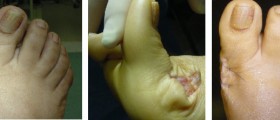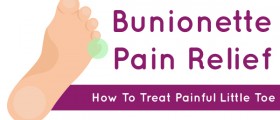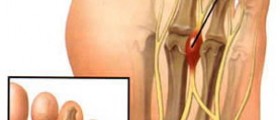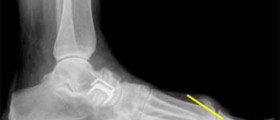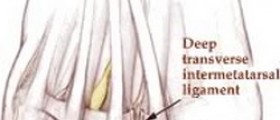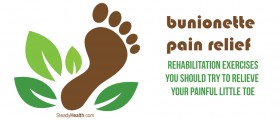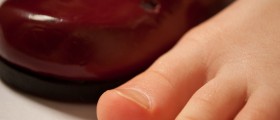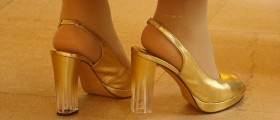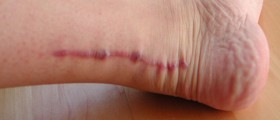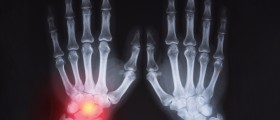The key to successful bunionectomy is getting a good surgeon. Not all podiatrists are created equal. Some do very little surgery other than toenails, some do lots of surgery. My surgeries, (one on each foot) were sore for one or two days, and now, are completely pain free. It was by far the most sucessful surgery I've ever had. GET A GOOD SURGEON!!!! ASK AROUND!! ASK MD'S, see what hospitals the podiatrists go to. If they only go to surgicenters, that is a huge red flag. If they go to a major hospital, then that tells you they can pass the standards of the hospital to get rights to practice there, ie a residency, board certified, etc.
I wore a boot for about a month and I had no problems. No pain except for day 1 and 2, and only when I walked on it to go to the batthroom etc, but that is to be expected. It wasn't that bad. GOOD LUCK TO YOU ALL.
I wore a boot for about a month and I had no problems. No pain except for day 1 and 2, and only when I walked on it to go to the batthroom etc, but that is to be expected. It wasn't that bad. GOOD LUCK TO YOU ALL.
Loading...
Hello. I am one week out of a Bunionectomy with Osteotomy and 2nd digit artheoplasty. I wonder if I would have gone through with the surgery if I had read the postings here of the last two years. I am using a Podiatric Surgeon with operating privileges in a large well-known hospital here in southeast Florida. I have suffered with pain for quite a few years in both feet. The pain has gotten progressively worse and orthotics did not help. I started with the left foot, which was the worst. A bunion and a hammer toe on the second toe.
So far, the first 3 days were a blur of pain and pain meds (I am allergic to codeine so I could only have Darvoset). I was bandaged and sent home with a hard-soled walking sandal and an incredible shower boot that prevents water from coming in. I had borrowed a walker and a shower seat (both lifesavers as I live alone). My doctor told me to keep icing the foot, all the time that I am sitting or lying down with the foot eleveated. I should do this indefinately (not just the 72 hours).
Two days later I went to my doctor for an xray to see if the toe is straight. She also checked for infection and rewrapped the foot. Doc said to get a walking cane instead of a walker. Walking is painful and I can only stand now for about 5 minutes before the throbbing grips. I can walk about 30 feet and have stayed in my apartment this week.
I am very pleased with the doctor so far and her concern and clear directions. She never told me that recovery would be swift. As a matter of fact, she said that the swelling could last 6-8 mos.
I have taken 2 weeks off from work and plan to return on Jan 4. I will keep my foot elevated at work and will have the ice pack ready.
Today I will try to drive just in my development. If I can do that, tomorrow I will run 2 errands that don't require me getting out of the car. I sure wish I could get a handicapped tag for a short while. Something to ask the doctor.
My next appointment in New Year's Eve day where I will probably get the stitches out of the second toe. The pin is my big toe will be in a bit longer.
I pray that I don't experience the suffering that I read about on these posts. I will keep you informed.
So far, the first 3 days were a blur of pain and pain meds (I am allergic to codeine so I could only have Darvoset). I was bandaged and sent home with a hard-soled walking sandal and an incredible shower boot that prevents water from coming in. I had borrowed a walker and a shower seat (both lifesavers as I live alone). My doctor told me to keep icing the foot, all the time that I am sitting or lying down with the foot eleveated. I should do this indefinately (not just the 72 hours).
Two days later I went to my doctor for an xray to see if the toe is straight. She also checked for infection and rewrapped the foot. Doc said to get a walking cane instead of a walker. Walking is painful and I can only stand now for about 5 minutes before the throbbing grips. I can walk about 30 feet and have stayed in my apartment this week.
I am very pleased with the doctor so far and her concern and clear directions. She never told me that recovery would be swift. As a matter of fact, she said that the swelling could last 6-8 mos.
I have taken 2 weeks off from work and plan to return on Jan 4. I will keep my foot elevated at work and will have the ice pack ready.
Today I will try to drive just in my development. If I can do that, tomorrow I will run 2 errands that don't require me getting out of the car. I sure wish I could get a handicapped tag for a short while. Something to ask the doctor.
My next appointment in New Year's Eve day where I will probably get the stitches out of the second toe. The pin is my big toe will be in a bit longer.
I pray that I don't experience the suffering that I read about on these posts. I will keep you informed.
Loading...
Geetings all. I am a 38 yr old female that has had a base wedge osteotomy with pin sticking out of the foot and also the lump shaved off the side of the toe joint of the same foot 6 1/2 weeks ago. I had a fiberglass cast for 1st 3 weeks, then sutures were removed and pin left in along with a new cast put on. At the end of the following 3 weeks (total 6 weeks) the 2nd cast was removed and the large pin was pulled out (this was supposed to be painless but mine was somewhat stuck so it hurt a bit coming out otherwise not to bad.) I was then told I could begin walking on my heel to start and go from there along with home physical therapy exercises. Two days later my foot was looking bruised and purple looking on sections of it so I called the surgeon and he had me come in to re-xray it to make sure there were no fractures. By the time I got in there it was looking much better and there were no fractures. He had a long talk with me about needing to not baby it at this point and I had to force myself to start walking on it. I was having alot of nerve sensitivity on the side of the foot where the surgery was and he discussed 2 cases he had in his career of a terribly painful nerve condition that patients developed in part because they didn't work through the pain and they babied the foot and wouldn't try to walk. I promptly went home, put on a light compression sock he now wants me to wear and I began walking. To my surprise I wasn't in as much pain as I thought I was in and realized my mind was actually working against me which made it difficult to start walking. I hope everyone can find a surgeon like mine that not only works on the physical problem but also understands that your mind can interfere with your progress and help you get past that. I'm definitely uncomfortable but I am actually walking slowly at 6 1/2 weeks post op from a really major procedure and I think that is amazing. I hope this info helps others and I would be happy to answer anything that might help someone else in my situation.
Loading...
WHAT??????????????????? they gave you darvocet? The guy should be sued for malpractice. A bunionectomy with osteotomy is PAINFUL. They are debating whether to take darvon, darvocet, etal off the market because its less effective than a tylenlol. If you are allergic to codeine, then he should have used percocet. If that doesnt work, morphine. I would complain to the board and possibly talk to an attorney. That is a CROCK OF XXXX. (you can fill in the 4 x's.) IN ADDITION TO IT NOT WORKING, IT SAYS IT IN SECOND ARTICLE, ITS DANGEROUS. ITS TOXIC TO YOUR HEART, AND ANY DR WHO USES IT WITHOUT A VERY GOOD REASON SHOULD HAVE A COMPLAINT FILED AND A LAWYER CONSULTED. ESPECIALLY IF ITS GIVEN AFTER AN OSTEOTOMY WHICH IS CUTTING BONES IN HALF AND PINNING TOGETHER. ITS VERY PAINFUL. DARVOGARBAGE WONT EVEN COME NEAR TOUCHING THAT ONE. IT WONT BE ON THE MARKET IN A YEAR, YOU CAN COUNT ON THAT. SECONDLY IF YOU ARE ALLERGIC TO CODEINE, 99% OF DOCTORS (ASSUMING YOU ARE NOT AFTER NARCOTICS) WILL EITHER GIVE YOU VICODIN OR PERCOCET POST OP. NONE WILL GIVE YOU DARVOCET UNLESS HIS PRESCRIPTION PRIVLIDGES ARE LIMITED DUE TO ABUSE--MAYBE HE CANNOT RX C2 OR C3? OR MAYBE HE IS A DRUG ADDICT AND ITS OK FOR HIM BUT NOT FOR YOU. THIS MAKES ME MAD BECAUSE I KNOW YOU SUFFERED. DARVOCET IS TRASH. Read this:
FDA Advised to Pull Darvocet Off Market
February 5, 2009
The pain medications Darvon and Darvocet should be pulled off the market, according to a recommendation approved on a 14-12 vote by a panel of medical experts assembled by the Food and Drug Administration (FDA).
CNN reported Jan. 30 that the panel said the risks of death from cardiac problems that are associated with the drugs -- both of which contain the active ingredient propoxyphene -- outweighed their benefits. However, the FDA is responsible for the final decision.
The drugs have been linked to heart problems and also carry the risk of addiction. They also can cause death when used in combination with alcohol or other drugs.
The FDA will also consider the possibility of ordering post-market studies or changing the drugs' labels, said Sharon Hertz, deputy director of FDA's anesthesia, analgesia and rheumatology products division.
Darvon, developed by Eli Lilly & Co., has been sold for 50 years in the U.S. Lilly also created Darvocet, which contains both propoxyphene and acetaminophen.
The panel was prompted to meet after a public-advocacy organization, Public Citizen, petitioned and then sued the FDA to remove the products.
"All drugs have risks," said Sidney Wolfe, director of Public Citizen's health research group. "If they don't have benefits they need to come off the market." Wolfe presented the panel with data showing 503 deaths in 2007 in which propoxyphene was a contributing factor.
Here is more:
Title: Darvon, Darvocet and Other Prescription Painkillers
Author: Jim Parker
Publisher: Do It Now Foundation
Date: February 2007
Catalog Number: 157
--------------------------------------------------------------------------------
..Lumps
Darvon sure has been taking its lumps lately.
Oh, things were fine for a while, and Darvon, which was introduced in the United States in 1957, kept plugging along, year after year, near the top of the list of most-prescribed medications.
For almost two decades, it ranked right behind Valium and Librium as one of America's most popular prescription drugs, averaging 39 million prescriptions a year between 1973 and 1975.
Then things began to go sour.
It started when propoxyphene (the generic name for Darvon) was cited in 589 overdose deaths in 23 U.S. cities. This led the Ralph Nader-affiliated Health Research Group to demand a federal ban on use of the painkiller.
Calling it "the deadliest prescription drug in the United States," the group argued that propoxyphene figures into thousands of deaths and medical emergencies each year -- many of them accidental overdoses.
It continued when the 1989 Darvon-related death of former NFL great John Matuszak prompted the group to renew its demand for removal of the drug from the U.S. market.
Somewhere in between, the U.S. Food and Drug Administration stepped up its campaign against Darvon, limiting how and when and for how long doctors could prescribe the drug.
So what's everybody got against Darvon, anyway? And why, in spite of a lot of people's best efforts, won't it (and other propoxyphene-based drugs like it) go away?
Good questions. But to answer them fully we first have to look closely at the make-up and properties of the drug itself: the chemical propoxyphene.
--------------------------------------------------------------------------------
..What it is, what it isn't
So what is propoxyphene?
Structurally, it's a relative of the synthetic narcotic, methadone. It's prescribed in two forms -- propoxyphene hydrochloride and propoxyphene napsylate -- for relief of mild to moderate pain.
Aside from slight differences -- the napsylate (or N-form) of propoxyphene is more slowly absorbed in the body and so has a longer duration of action -- the two drugs are identical. Both are found in a number of prescription pain medications, including:
Darvon and Darvon-N (propoxyphene only)\
Darvon with A.S.A., Darvon-N with A.S.A. (with aspirin)
Darvocet, Darvocet-N, Wygesic (with acetaminophen)
Darvon Compound, Darvon Compound-65 (with aspirin and caffeine)
But in whatever form, propoxyphene is prescribed and sold as a mild analgesic for pain that won't stop with aspirin.
So why all the fuss?
For one thing, Darvon doesn't work -- at least not as well as it was supposed to when it was introduced back in 1957. At that time, its manufacturer, Eli Lilly and Company, promoted it as a safe, non-addicting substitute for codeine.
But the closer people looked, the less Darvon looked like a safe, non-addicting substitute for anything. In fact, in 1972, after clinical studies qued propoxyphene's effectiveness as a pain reliever, Lilly was required to release a statement backing off some of its earlier claims on behalf of the drug.
Acknowledging that "the preponderance of evidence indicates that it may be somewhat less potent than codeine," Lilly even conceded in its retraction there was "no substantial evidence to demonstrate that 65mg of Darvon is more effective than 650mg of aspirin [two standard tablets]."
No more effective than aspirin? Some authorities, including the American Medical Association's Drug Evaluations, went a step further, arguing that a dose of propoxyphene is actually less effective than a normal dose of aspirin.
Okay, so if propoxyphene is less effective and less potent than codeine and no better than two aspirin in relieving pain, what good is it, anyway?
Another good question, and one that gets more interesting the closer you get to the serious hazards associated with propoxyphene.
--------------------------------------------------------------------------------
..Risks & Realities
When people run into problems with propoxyphene, it's often due in large part to the drug's ineffectiveness.
Since it's most often prescribed for relief of pain, propoxyphene can easily be misused -- particularly when relief does not appear to be fast or forthcoming. But pain sufferers who self-prescribe a double dose of Darvon when a first dose fails may be writing themselves a prescription for trouble.
Reasons revolve around unusual properties of the drug itself.
For one thing, the gap between a therapeutic dose and an overdose is small. This margin of safety is so slight, in fact, that as little as four times the standard dose can trigger a dangerous slowing of breathing and heart rate. Six times a therapeutic dose can cause seizures and symptoms of toxic psychosis.
Darvon's small safety margin shrinks further if the drug is taken with alcohol or other depressants.
In fact, more than 93 percent of all propoxyphene-related deaths in 1995 were the result of interactions with other drugs -- more than half involving alcohol or diazepam. (Valium)
--------------------------------------------------------------------------------
..Addiction and Other Dangers
Given propoxyphene's similarities to methadone, it's not surprising that the drug is as addictive as it is.
In fact, the medical journal Clinical Pharmacology even argued that propoxyphene's "most prominent effect...may be its addictive quality."
And that danger hasn't been lost on a generation of users, either.
Darvon produces psychological and physical dependence like other narcotics, and treatment for Darvon dependence is much the same, too.
Other risks are tied to the presence of substances often found in propoxyphene preparations. Aspirin and acetaminophen are particularly dangerous since they can damage the liver and kidneys when overused.
Similarly, heavy doses of caffeine (found in Darvon Compound and Darvon Compound-65) can cause jitteriness, insomnia, and anxiety -- which some users relieve by taking tranquilizers or sleeping pills, which further compounds the risk of overdose.
That brings us to a final danger of Darvon that's confronted too many users over the years: a potentially-fatal overdose syndrome.
Symptoms are similar to other narcotics overdoses, and include convulsions, stupor, pinpoint pupils, respiratory depression, and coma.
But propoxyphene overdoses are doubly deadly because they happen so quickly.
In fact, one study has showed that 20 percent of fatal overdoses occurred in the first hour after ingestion of the drug.
Due to the seriousness of a propoxyphene OD and the rapid onset of symptoms, medical help should be sought immediately.
--------------------------------------------------------------------------------
..Darvon Today
Given the lumps that Darvon's been taking lately, it would seem to follow that propoxyphene would almost have disappeared as a drug problem by now, right?
Wrong.
Wrong. Propoxyphene figured into 6,448 emergency room admissions nationwide in 2004, and was cited by medical examiners in four major U.S. cities as one of the ten leading causes of drug fatalities for 2002.
And in spite of its limitations and hazards associated with its use, thousands of doctors still dash off prescriptions for propoxyphene for a range of ailments, great and small.
--------------------------------------------------------------------------------
..The problem that won't quit
So what's a troubled pain sufferer to do?
Well, if you're routinely taking Darvon (or any of the other propoxyphene drugs) for everyday aches or pains, and you've been taking it for some time, you might look seriously at giving it up -- or at least talking over your situation with a physician.
If you've been prescribed propoxyphene for a brand-new pain, take the drug only as directed and stop at your first opportunity.
And if you're taking Darvon because you're addicted to it (or you think you might be), contact a local drug treatment facility to get some help for yourself.
Because in spite of all the lumps it's taken, Darvon is still all too capable of inflicting a few lumps of its own, particularly to people who don't know what they're dealing with.
And while ignorance about some things can be bliss, with a drug as potentially dangerous as Darvon, ignorance is only ignorance.
And, sometimes, it's deadly.
--------------------------------------------------------------------------------
..Sidebar | Rx: Prescription Narcotics
A number of Darvon-like natural and synthetic narcotics are widely used as pain relievers today. When used properly, these drugs can mean the difference between incapacitating pain and normal functioning. But when overused or used improperly, they can produce the same problems as propoxyphene: overdose, addiction, and other health risks.
The most common side effects of the prescription pain relievers listed below are a group of symptoms that include dizziness, sedation, and nausea or vomiting. Other effects include flushing or tingling of the skin, dry mouth, lethargy, impaired concentration, and constipation. Like propoxyphene, all produce varying degrees of physical and psychological dependence. Each also produces tolerance, or a need to boost dosage in order to achieve similar effects.
Although the drugs have a broad range of effects and abuse potential, they share one thing in common: a nasty overdose syndrome that can be life threatening. Symptoms of overdose include pinpoint pupils, muscle flaccidity, depression of breathing and heart rate, stupor, and coma. Medical intervention is essential.
Probably the best advice to follow with all prescription narcotics is to take them with a healthy dose of caution. Because while their effects -- and dangers -- can range from very mild to very severe, they all can take away something infinitely more important than pain when used incorrectly. And they can all be used incorrectly.
Drug Name Trade Name(s) Other Drugs Present Physical Dependence Psychological Dependence
Codeine Tylenol #1,2,3,4
Empirin #1,2,3,4 Acetaminophen
Aspirin Low Moderate
Oxycodone Percodan
Percocet Aspirin
Acetaminophen High High
Hydromorphone Dilaudid -- High High
Meperidine Demerol -- High High
Pentazocine Talwin-50
Talwin-NX Naloxone Low-Moderate Moderate-High
FDA Advised to Pull Darvocet Off Market
February 5, 2009
The pain medications Darvon and Darvocet should be pulled off the market, according to a recommendation approved on a 14-12 vote by a panel of medical experts assembled by the Food and Drug Administration (FDA).
CNN reported Jan. 30 that the panel said the risks of death from cardiac problems that are associated with the drugs -- both of which contain the active ingredient propoxyphene -- outweighed their benefits. However, the FDA is responsible for the final decision.
The drugs have been linked to heart problems and also carry the risk of addiction. They also can cause death when used in combination with alcohol or other drugs.
The FDA will also consider the possibility of ordering post-market studies or changing the drugs' labels, said Sharon Hertz, deputy director of FDA's anesthesia, analgesia and rheumatology products division.
Darvon, developed by Eli Lilly & Co., has been sold for 50 years in the U.S. Lilly also created Darvocet, which contains both propoxyphene and acetaminophen.
The panel was prompted to meet after a public-advocacy organization, Public Citizen, petitioned and then sued the FDA to remove the products.
"All drugs have risks," said Sidney Wolfe, director of Public Citizen's health research group. "If they don't have benefits they need to come off the market." Wolfe presented the panel with data showing 503 deaths in 2007 in which propoxyphene was a contributing factor.
Here is more:
Title: Darvon, Darvocet and Other Prescription Painkillers
Author: Jim Parker
Publisher: Do It Now Foundation
Date: February 2007
Catalog Number: 157
--------------------------------------------------------------------------------
..Lumps
Darvon sure has been taking its lumps lately.
Oh, things were fine for a while, and Darvon, which was introduced in the United States in 1957, kept plugging along, year after year, near the top of the list of most-prescribed medications.
For almost two decades, it ranked right behind Valium and Librium as one of America's most popular prescription drugs, averaging 39 million prescriptions a year between 1973 and 1975.
Then things began to go sour.
It started when propoxyphene (the generic name for Darvon) was cited in 589 overdose deaths in 23 U.S. cities. This led the Ralph Nader-affiliated Health Research Group to demand a federal ban on use of the painkiller.
Calling it "the deadliest prescription drug in the United States," the group argued that propoxyphene figures into thousands of deaths and medical emergencies each year -- many of them accidental overdoses.
It continued when the 1989 Darvon-related death of former NFL great John Matuszak prompted the group to renew its demand for removal of the drug from the U.S. market.
Somewhere in between, the U.S. Food and Drug Administration stepped up its campaign against Darvon, limiting how and when and for how long doctors could prescribe the drug.
So what's everybody got against Darvon, anyway? And why, in spite of a lot of people's best efforts, won't it (and other propoxyphene-based drugs like it) go away?
Good questions. But to answer them fully we first have to look closely at the make-up and properties of the drug itself: the chemical propoxyphene.
--------------------------------------------------------------------------------
..What it is, what it isn't
So what is propoxyphene?
Structurally, it's a relative of the synthetic narcotic, methadone. It's prescribed in two forms -- propoxyphene hydrochloride and propoxyphene napsylate -- for relief of mild to moderate pain.
Aside from slight differences -- the napsylate (or N-form) of propoxyphene is more slowly absorbed in the body and so has a longer duration of action -- the two drugs are identical. Both are found in a number of prescription pain medications, including:
Darvon and Darvon-N (propoxyphene only)\
Darvon with A.S.A., Darvon-N with A.S.A. (with aspirin)
Darvocet, Darvocet-N, Wygesic (with acetaminophen)
Darvon Compound, Darvon Compound-65 (with aspirin and caffeine)
But in whatever form, propoxyphene is prescribed and sold as a mild analgesic for pain that won't stop with aspirin.
So why all the fuss?
For one thing, Darvon doesn't work -- at least not as well as it was supposed to when it was introduced back in 1957. At that time, its manufacturer, Eli Lilly and Company, promoted it as a safe, non-addicting substitute for codeine.
But the closer people looked, the less Darvon looked like a safe, non-addicting substitute for anything. In fact, in 1972, after clinical studies qued propoxyphene's effectiveness as a pain reliever, Lilly was required to release a statement backing off some of its earlier claims on behalf of the drug.
Acknowledging that "the preponderance of evidence indicates that it may be somewhat less potent than codeine," Lilly even conceded in its retraction there was "no substantial evidence to demonstrate that 65mg of Darvon is more effective than 650mg of aspirin [two standard tablets]."
No more effective than aspirin? Some authorities, including the American Medical Association's Drug Evaluations, went a step further, arguing that a dose of propoxyphene is actually less effective than a normal dose of aspirin.
Okay, so if propoxyphene is less effective and less potent than codeine and no better than two aspirin in relieving pain, what good is it, anyway?
Another good question, and one that gets more interesting the closer you get to the serious hazards associated with propoxyphene.
--------------------------------------------------------------------------------
..Risks & Realities
When people run into problems with propoxyphene, it's often due in large part to the drug's ineffectiveness.
Since it's most often prescribed for relief of pain, propoxyphene can easily be misused -- particularly when relief does not appear to be fast or forthcoming. But pain sufferers who self-prescribe a double dose of Darvon when a first dose fails may be writing themselves a prescription for trouble.
Reasons revolve around unusual properties of the drug itself.
For one thing, the gap between a therapeutic dose and an overdose is small. This margin of safety is so slight, in fact, that as little as four times the standard dose can trigger a dangerous slowing of breathing and heart rate. Six times a therapeutic dose can cause seizures and symptoms of toxic psychosis.
Darvon's small safety margin shrinks further if the drug is taken with alcohol or other depressants.
In fact, more than 93 percent of all propoxyphene-related deaths in 1995 were the result of interactions with other drugs -- more than half involving alcohol or diazepam. (Valium)
--------------------------------------------------------------------------------
..Addiction and Other Dangers
Given propoxyphene's similarities to methadone, it's not surprising that the drug is as addictive as it is.
In fact, the medical journal Clinical Pharmacology even argued that propoxyphene's "most prominent effect...may be its addictive quality."
And that danger hasn't been lost on a generation of users, either.
Darvon produces psychological and physical dependence like other narcotics, and treatment for Darvon dependence is much the same, too.
Other risks are tied to the presence of substances often found in propoxyphene preparations. Aspirin and acetaminophen are particularly dangerous since they can damage the liver and kidneys when overused.
Similarly, heavy doses of caffeine (found in Darvon Compound and Darvon Compound-65) can cause jitteriness, insomnia, and anxiety -- which some users relieve by taking tranquilizers or sleeping pills, which further compounds the risk of overdose.
That brings us to a final danger of Darvon that's confronted too many users over the years: a potentially-fatal overdose syndrome.
Symptoms are similar to other narcotics overdoses, and include convulsions, stupor, pinpoint pupils, respiratory depression, and coma.
But propoxyphene overdoses are doubly deadly because they happen so quickly.
In fact, one study has showed that 20 percent of fatal overdoses occurred in the first hour after ingestion of the drug.
Due to the seriousness of a propoxyphene OD and the rapid onset of symptoms, medical help should be sought immediately.
--------------------------------------------------------------------------------
..Darvon Today
Given the lumps that Darvon's been taking lately, it would seem to follow that propoxyphene would almost have disappeared as a drug problem by now, right?
Wrong.
Wrong. Propoxyphene figured into 6,448 emergency room admissions nationwide in 2004, and was cited by medical examiners in four major U.S. cities as one of the ten leading causes of drug fatalities for 2002.
And in spite of its limitations and hazards associated with its use, thousands of doctors still dash off prescriptions for propoxyphene for a range of ailments, great and small.
--------------------------------------------------------------------------------
..The problem that won't quit
So what's a troubled pain sufferer to do?
Well, if you're routinely taking Darvon (or any of the other propoxyphene drugs) for everyday aches or pains, and you've been taking it for some time, you might look seriously at giving it up -- or at least talking over your situation with a physician.
If you've been prescribed propoxyphene for a brand-new pain, take the drug only as directed and stop at your first opportunity.
And if you're taking Darvon because you're addicted to it (or you think you might be), contact a local drug treatment facility to get some help for yourself.
Because in spite of all the lumps it's taken, Darvon is still all too capable of inflicting a few lumps of its own, particularly to people who don't know what they're dealing with.
And while ignorance about some things can be bliss, with a drug as potentially dangerous as Darvon, ignorance is only ignorance.
And, sometimes, it's deadly.
--------------------------------------------------------------------------------
..Sidebar | Rx: Prescription Narcotics
A number of Darvon-like natural and synthetic narcotics are widely used as pain relievers today. When used properly, these drugs can mean the difference between incapacitating pain and normal functioning. But when overused or used improperly, they can produce the same problems as propoxyphene: overdose, addiction, and other health risks.
The most common side effects of the prescription pain relievers listed below are a group of symptoms that include dizziness, sedation, and nausea or vomiting. Other effects include flushing or tingling of the skin, dry mouth, lethargy, impaired concentration, and constipation. Like propoxyphene, all produce varying degrees of physical and psychological dependence. Each also produces tolerance, or a need to boost dosage in order to achieve similar effects.
Although the drugs have a broad range of effects and abuse potential, they share one thing in common: a nasty overdose syndrome that can be life threatening. Symptoms of overdose include pinpoint pupils, muscle flaccidity, depression of breathing and heart rate, stupor, and coma. Medical intervention is essential.
Probably the best advice to follow with all prescription narcotics is to take them with a healthy dose of caution. Because while their effects -- and dangers -- can range from very mild to very severe, they all can take away something infinitely more important than pain when used incorrectly. And they can all be used incorrectly.
Drug Name Trade Name(s) Other Drugs Present Physical Dependence Psychological Dependence
Codeine Tylenol #1,2,3,4
Empirin #1,2,3,4 Acetaminophen
Aspirin Low Moderate
Oxycodone Percodan
Percocet Aspirin
Acetaminophen High High
Hydromorphone Dilaudid -- High High
Meperidine Demerol -- High High
Pentazocine Talwin-50
Talwin-NX Naloxone Low-Moderate Moderate-High
Loading...
I had my bunionectomy 10 weeks ago. I had an opening wedge osteotomy (metacarsal bone with 4 screws and metal plate), big toe osteotomy with 1 screw and the side of bunion shaved. I was in a cast for 8 weeks. I had pain during the first 3 weeks. My doctor told me that I would lose some of the range of motion. I started walking in my walking boot two weeks ago. It hurt really bad the first day but I made myself put all my weight on it because I was so tired of not walking. The next day, the pain wasn't as bad. I started PT two days after walking. I've been going to PT 3 times a weeks. I didn't have much feeling in my toe and was very stiff. My toe would only bend to 30 degrees. I've been doing lots of stretching and strengthening of the big toe joint. It is painful but I love losing that stiffness. Now, at 10 weeks, I just started getting feeling back in my toe which is great. My toe bends to 40 degrees now which I'm happy about. The more walking, stretching and strenghtening you do, the quicker you will return back to normal. My favorite exercises (to make toe move downward) is picking up marbles with only your big toe. My favorite exercise ( to make toe move upwards) is walking backwards using long strides. Also, massage scar twice a day to reduce scar tissue. My scar is getting flatter and looking and feeling much better. Taking Vitamin E internally is supposed to help heal the scar, not topically. I use Mederma topically which seems to help fade my scar but massage is really helping to reduce scar tissue. I hope this helps and get threw the pain and you will feel better sooner.
Loading...
I had also bunionectomy 1.5 years ago. I had/have the same symtoms as some of you, mostly tissue soreness. It feels like I have glass or needles inside the foot joint. In June, I had one of the screws out. It helped but the pain comes back off and on. If the temperature is cold, it can get worst for a moment, then goes away with the heat. Lately, what has helped the most is soaking my foot in coarse salt or other natural salts with hot water as much as I can bear. The salt/heat softens the tissue and in a few days swelling starts going away. Not only hot, afterwards an ice pack and viceversa. Pour the salt and water in a bucket, and place the foot in. Success!! I know pain seems not go away.
Loading...
Had bunionectomy, and osteotomy.
Both feet in 3rd week feb 2011. Dr. Advised bed rest 2 weeks. Did just that.
No movement at all, bed bound, feet up for 20 hrs a day for 2weeks.
Thereion, it's been crutches and a walking stick. The stitches healed in 4weeks. No screws or pins after surgery.
Close to 8weeks now. Can handle staying up on feet most of the day. 3 to 5 hours walking, casual day kind, are also
Manageable , with intermittent rest. yes the feet swell up by end of day, yes it is a lil painful.
Good news is getting back to normal. Toes are flexible, as much as they can be at 8 weeks.
Worth it ! Recommended.
Loading...
Hi, i just recently had a bunionectomy on my right foot, my dr reconstructed my toe because the dr who did it before did it wrong and my surgery took five hours instead of two, he put a fragment in my toe because i had no more soft tissue in my toe. He took off part of my bone so my toe is completly straight now which has never happened before and i have had two surgeries one on each toe left and right and they still did not striaghten it out all the way like this dr did. I had surgery on december 6th of 2011. I am still in so much pain, is this normal? The dr wants me to do toe exercises so my toe does not stiffen up and i am doing that but the pain is unbearable, and no one understands it unless they went through it, so that is why i am writing this now. He gave me pain meds for it but i can not take them cause they make me sick so i am dealing with the pain with just mortin and tylenol. What i am wondering is has anyone ever left like there foot is either boiling hot, or really cold where it feels numb? Has anyone experienced not being able to really lift your foot up because you have a hard time and your foot is stiff? If so how long does it last it has been a long time since my last surgery? If someone can get back to me i would appreciate it cause i am in so much pain and i just want to know if this is normal? thanks carrie
Loading...
I had bunionectomy approx. 10 weeks ago. initial cast for 2 weeks then boot (too heavy) then doc provided shoe. I used crutches for 3 weeks during healing process. I am able to walk in sneakers and flats, but my foot feels heavy and have pain in my second toe and midpoint of my foot after 4-5 hours of walking while cleaning house, laundry. I haven't tried drving yet because of pain and stiffness with exerted force - afraid of using the break pedal in my car and not being able to apply enough pressure. I have had the stiffness, pain, and heavy foot feeling along with burning and intermittant numbness/pain in different areas of my foot. I believe the doc/surgeon I chose is excellent since he has been performing bunionectomies for many years. what could my prob be? anyone else had similar effects?
Loading...
Hi,
It has been over a year since your post but I wanted to see how the running was going? I had the op on both feet in South Africa almost 9 years ago. I experience some limited movement in my toe for quite some time, but I have not had any pain from about 2 months post op- very lucky as it seems many people have struggled post op. I must admit that I didnt need pain killers after one week post op and havent needed since. I also run a lot and have recently started experiencing pain in my feet (I think around the pins) and was considering orthotics- could you tell me a bit about yours please?
Many thanks!
It has been over a year since your post but I wanted to see how the running was going? I had the op on both feet in South Africa almost 9 years ago. I experience some limited movement in my toe for quite some time, but I have not had any pain from about 2 months post op- very lucky as it seems many people have struggled post op. I must admit that I didnt need pain killers after one week post op and havent needed since. I also run a lot and have recently started experiencing pain in my feet (I think around the pins) and was considering orthotics- could you tell me a bit about yours please?
Many thanks!
Loading...
I truly understand and feel everyone's pain on these posts. I was crying earlier, silly I know, because of the complications and pain in my foot after the surgery. Too much walking or pressure can aggravate the pain. I had surgery done years ago. One year after the surgery, I got severe swelling under my first metatarsal after wearing some platform sandals, first time I wore normal shoes. It didn't seem like a bad idea, but now I have metatarsalgia - the feeling of walking with a rock under the ball of your foot. It throws off my gait and stability, forcing me to walk on the side of my foot. Doctors don't tell us the possibility of that happening, or the excessive scar tissue that can lead to joint stiffness.
I did find something that worked a bit for the pain; I like homeopathic/natural remedies. If you go to a Mexican Food market, they sell green cactus pieces. They are thin, long and prickly naturally. Well, a friend of mine had bone spurs in his heel and was told by a chinese doctor to slice the cactus piece in half. This will expose the inside, which is gooey - kind of has a creamy, sticky texture to it. What you do is then take a small piece of that gooey side and place it under the ball of your foot, so it covers your foot like a band-aid. You naturally have to keep the cactus in place by wrapping some ace bandage around your foot, like when you had the surgery. Make sure the gooey side of the cactus coats the ball of your foot. It will feel cold. Do this right before bed. Wrap your foot with the cactus and ace bandage and leave it overnight. When you remove it in the morning, the cactus will be dried up. Repeat this step every night for two weeks. This might sound crazy and unconventional, but I tried it and I felt it soothed the pain and swelling quite a bit. My friend swore by it. Instead of having dangerous surgery for heel spurs, he did this for two weeks and no longer has pain. You never know nature's way of treating our wounds.
Also, accupuncture on the bottom of the foot helps a lot.Foot massages are great as well. Best of luck to all. I pray for relief from this horrible pain.
I did find something that worked a bit for the pain; I like homeopathic/natural remedies. If you go to a Mexican Food market, they sell green cactus pieces. They are thin, long and prickly naturally. Well, a friend of mine had bone spurs in his heel and was told by a chinese doctor to slice the cactus piece in half. This will expose the inside, which is gooey - kind of has a creamy, sticky texture to it. What you do is then take a small piece of that gooey side and place it under the ball of your foot, so it covers your foot like a band-aid. You naturally have to keep the cactus in place by wrapping some ace bandage around your foot, like when you had the surgery. Make sure the gooey side of the cactus coats the ball of your foot. It will feel cold. Do this right before bed. Wrap your foot with the cactus and ace bandage and leave it overnight. When you remove it in the morning, the cactus will be dried up. Repeat this step every night for two weeks. This might sound crazy and unconventional, but I tried it and I felt it soothed the pain and swelling quite a bit. My friend swore by it. Instead of having dangerous surgery for heel spurs, he did this for two weeks and no longer has pain. You never know nature's way of treating our wounds.
Also, accupuncture on the bottom of the foot helps a lot.Foot massages are great as well. Best of luck to all. I pray for relief from this horrible pain.
Loading...
I had both feet done in late August of 2011. My doctor and his assistant both operated on me at the same time. I had a mild case of hammertoe which was corrected on both feet. Now I don't know who operated on each foot but I'm 11 months post op and my left foot is still in pain. I can't wear any of my old shoes for both of my feet are larger than before. I hate walking long distances and can barely move the big toe on my left foot. I can not wear any closed toe shoes unless they are tennis shoes or wide toed boots. Nothing with a heel over 2inches... UGH!!! I'm 37 and walk & wear shoes like a little old lady... These doctors need to get off their high horses and start telling people the naked truth about Bunion surgery. I feel I was misled. Then to top it all off I was laid off @ months after surgery and lost my medical coverage so I cant get a revision to correct this mess.
Loading...
I am fast coming to the same conclusion as you. I wish I had just left well alone. Just seem to have swopped one problem (that I could cope with) to several others that are much worse. If anyone out there is considering bunion surgery please note the medical profession do not give you enough information to make a proper informed choice. I am NOT having the other foot done. I am at week 12 post operation now and to be honest my right foot is worse than pre-op. Please read these boards and read of other folks problems before deciding
Loading...
You guys are scaring me. I am in my 4th week of surgery and my foot is still swollen around the toe...it looks the same with no improvement. i was told that i should be walking with my boot this week already, but i'm afraid to even do it unless my swelling goes down. Also, with some of you having issues years later is really scaring me. I thought it would be smooth sailing at least from 6 months on out.
Loading...
I have burning pain constantly where my bunionectomy was performed, I cant stand it, it hurts worse than before the bone was ever messed with! I'm beginning to think its the screws themselves or something because they throb and burn and cramp up at the joints!
Loading...



